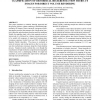Free Online Productivity Tools
i2Speak
i2Symbol
i2OCR
iTex2Img
iWeb2Print
iWeb2Shot
i2Type
iPdf2Split
iPdf2Merge
i2Bopomofo
i2Arabic
i2Style
i2Image
i2PDF
iLatex2Rtf
Sci2ools
AIA
2007
2007
Classification of biomedical high-resolution micro-CT images for direct volume rendering
This paper introduces a machine learning approach into the process of direct volume rendering of biomedical highresolution 3D images. More concretely, it proposes a learning pipeline process that generates the classification function within the optical property function used for rendering. Briefly, this pipeline starts with a data acquisition and selection task, it is followed by a feature extraction process, to be ended with sequence of supervised learning steps. Learning comprises Gentle Boost and CRF (Conditional Random Fields) classifiers. The process is evaluated in terms of accuracy and overlap metrics so that we can measure how performance increases along the whole pipeline process. Empirical results confirm that, even though the classification of high-resolution computerized tomography volume data poses a challenging problem for single-run classifiers, it can be significantly improved by subsequent learning steps and refinements. KEYWORDS Machine Learning, Biomedical 3...
AIA 2007 | Artificial Intelligence | Conditional Random Fields | Machine Learning | Pipeline Process |
| Added | 29 Oct 2010 |
| Updated | 29 Oct 2010 |
| Type | Conference |
| Year | 2007 |
| Where | AIA |
| Authors | Maite López-Sánchez, Jesús Cerquides, David Masip, Anna Puig |
Comments (0)

